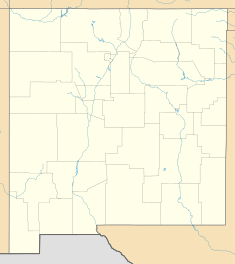Brantley Dam facts for kids
Quick facts for kids Brantley Dam |
|
|---|---|
|
Location of Brantley Dam in New Mexico
|
|
| Country | United States |
| Location | Eddy County, New Mexico |
| Coordinates | 32°32′39″N 104°22′52″W / 32.54419°N 104.381193°W |
| Purpose | Irrigation and flood control |
| Construction began | 1984 |
| Opening date | 1987 |
| Dam and spillways | |
| Height | 143.5 feet (43.7 m) |
| Length | 760 feet (230 m) |
| Reservoir | |
| Total capacity | 335,054 acre-feet (413,283,000 m3) |
Brantley Dam is a large dam built on the Pecos River in Eddy County, New Mexico. It helps control floods and stores water for farms. The dam is located about 13 miles (21 km) north of Carlsbad, New Mexico. It is also about 10 miles (16 km) upstream from another dam called Avalon Dam.
Contents
Why Was Brantley Dam Built?
Problems with Older Dams
In the 1960s, an older dam called McMillan Dam was having problems. It was filling up with silt, which is like fine dirt and sand. This meant it couldn't hold as much water as it used to.
Experts worried that a big flood could make McMillan Dam overflow. If that happened, both McMillan Dam and Avalon Dam could break. This would cause a lot of damage.
Planning a New Solution
In 1967, a plan was made for a new dam. This new dam would be built between Avalon Dam and McMillan Dam. It would be so big that it would cover the old McMillan reservoir completely.
In 1972, the United States Congress approved the project. They agreed to provide about $45 million to build the dam. Planning for the new dam continued throughout the 1970s.
Getting Ready for Construction
By the early 1980s, the land for the dam was bought and cleared. Workers also moved utility lines, like power cables. Major roads, including US 285 and NM 137, had to be moved. Even a railway line, the Santa Fe Railway, was rerouted at a cost of $15 million.
Construction on Brantley Dam officially began in 1984. The concrete parts of the dam were finished by the fall of 1987. Soon after, the Pecos River's water was sent through the new dam's floodgates for the first time.
How Brantley Dam Is Built
Dam's Main Parts
Brantley Dam has a strong concrete center section. On both the east and west sides, it has long sections made of rolled earth-fill. The entire dam is about 4 miles (6.4 km) long.
The central concrete part of the dam is about 143.5 feet (43.7 meters) high. It is also about 760 feet (230 meters) long. The earth-fill sections on the sides can be up to 118.5 feet (36.1 meters) high. Their top part, called the crest, is 30 feet (9.1 meters) wide.
Controlling Water Flow
The concrete section has a special overflow area called a spillway. This spillway has six gates that can open and close. These gates can release a lot of water very quickly, up to 352,000 cubic feet (9,967 cubic meters) per second. This helps prevent floods.
The dam also has two smaller tunnels, each 4 by 4 feet (1.2 by 1.2 meters). These are called outlet works. They can release water at a rate of 1,230 cubic feet (34.8 cubic meters) per second. This water is used for irrigation.
Brantley Lake: The Reservoir
What Is Brantley Lake?
Brantley Dam holds back the water of the Pecos River to create Brantley Lake. This lake stretches for about 16.5 miles (26.6 km) upstream from the dam.
Benefits of the Lake
Brantley Lake provides many important benefits. It supplies water for irrigation, helping farms grow crops. It also plays a big role in flood control, protecting nearby areas from heavy rains.
The lake is also good for fish and wildlife. It creates a habitat for many different animals. People can also enjoy recreation activities here. A part of the dam and the land around it is known as Brantley Lake State Park.
Brantley Lake can hold a huge amount of water for flood control, about 335,054 acre-feet (413.2 million cubic meters).


